Inverted full-backs are still quite a recent footballing innovation. Understanding them and their prominence fully emerged during Pep Guardiola’s spell at Bayern Munich in the Bundesliga. During his first season, Guardiola realised the impressive technical proficiency of Philip Lahm and his capability of playing in a more central role. David Alaba, as we are seeing currently, is also not poor technically. During his time at Manchester City in the Premier League, players such as Fabian Delph, Kyle Walker and Oleksandr Zinchenko have been associated with this role. The inversion of these wide players aligns to a key principle of positional play, controlling the midfield and occupying central areas.
For this analysis in the annotated images, the offensive team will be playing in a 4-3-3. This is predominantly because it is the one Guardiola has used when applying this concept, and he is the main trailblazer of inverted full-backs.
This tactical analysis piece, focusing on tactical theory, will look at the advantages and disadvantages of inverted full-backs. Additionally, by using analysis, I will look at their impact in both the offensive and defensive phases and the tactics used within them.
Build-up phase
Before anything I think we should look at a more linear build-up, with the relevant team here playing a 4-3-3 – naturally the build-up method changes as the formation does, which needs to be a factor when evaluating the viability of the full/wing-back(s) inverting. From a goal-kick scenario, the ball is almost certainly going to be played short to the centre-back – this is a trigger for the winger to press as the ball is now in play. Depending on the intensity of the opposition press the only feasible passing option is to the full-back out-wide, one of the few who has no immediate marker. However, due to the touchline pinning them in, subsequent passing options are limited, especially when the opposition shift across to maintain compactness. Furthermore, you are relying on the pass being accurate and the ball controlled swiftly. A scenario such as this is likely to culminate in a loss of possession.

Because the inversion of the full-backs essentially sacrifices the wide channels, the conditions for the full-back to invert must be advantageous. This is particularly relevant during the build-up phase due to a turnover potentially occurring closer to goal, with subsequent poor defensive coverage likely.
In essence, the main aim of the build-up phase is to create superiority. In the third of the pitch where this process is happening, the only possible superiorities are numerical and positional. The deeper aspiration here is the creation of a ‘free man’. A back-three is likely to create a numerical superiority upon the horizontal line in which they’re situated on. A lone or double-pivot can serve a similar purpose, by dropping in or forming a diamond shape, albeit this requires a degree of positional awareness. I’ll now look at some examples of where the inversion of full-backs can be helpful in the mechanism of ball progression through the thirds.

In this example above, the team in-possession is playing a 4-3-3 while the defensive side is lining-up in a 4-2-3-1. Appropriate positioning and coordinated pressing can create significant difficulties for the offensive side. The two wingers can cut off the passing lanes between centre-back and full-back while the ‘10’ can apply heavy pressure to the pivot. Looking at the image, there is no obvious option to aid clean ball progression – the opposition has a mix of zonal and man-marking that is structured in an idealistic way – of course, because football is so fluid and variable, such scenarios are tough to achieve consistently.
To counter this, and to create space aiding ball progression, movements need to be made to disrupt and imbalance the opposition defensive shape, such as the full-backs inverting. Because such an action is still quite rare in the modern game, this can result in the opposition becoming confused because of the unusual positioning of the full-back(s).
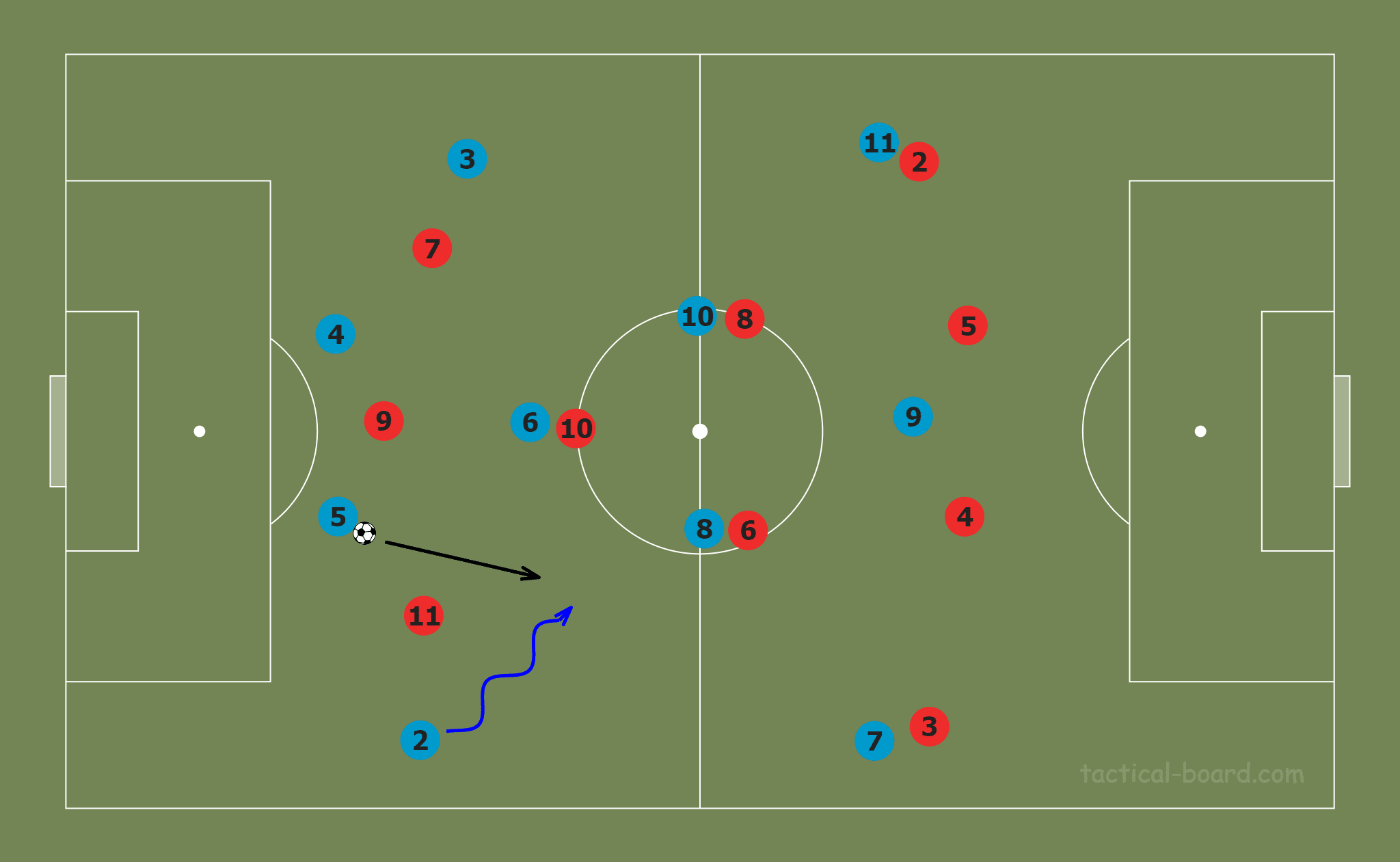
Whilst in the aforementioned pressing structure the full-back is in the cover shadow of the winger, a benefit to this is also possible. In the image above a sequence that involves a full-back inverting is demonstrated. This can be successful because the actual inverting motion is on the blindside of the winger who is covering the obvious passing lane between CB and FB. And, because the match-up of these specific two formations creates numerical equality in the midfield, the opponent’s midfielders cannot step out to press in fear of leaving the more offensive players free; they are therefore being pinned.
It’s also worthwhile looking at the effect of this mechanism versus alternative formations, and how superiority can be gained. First, let’s look at its practicality against a 4-3-3.
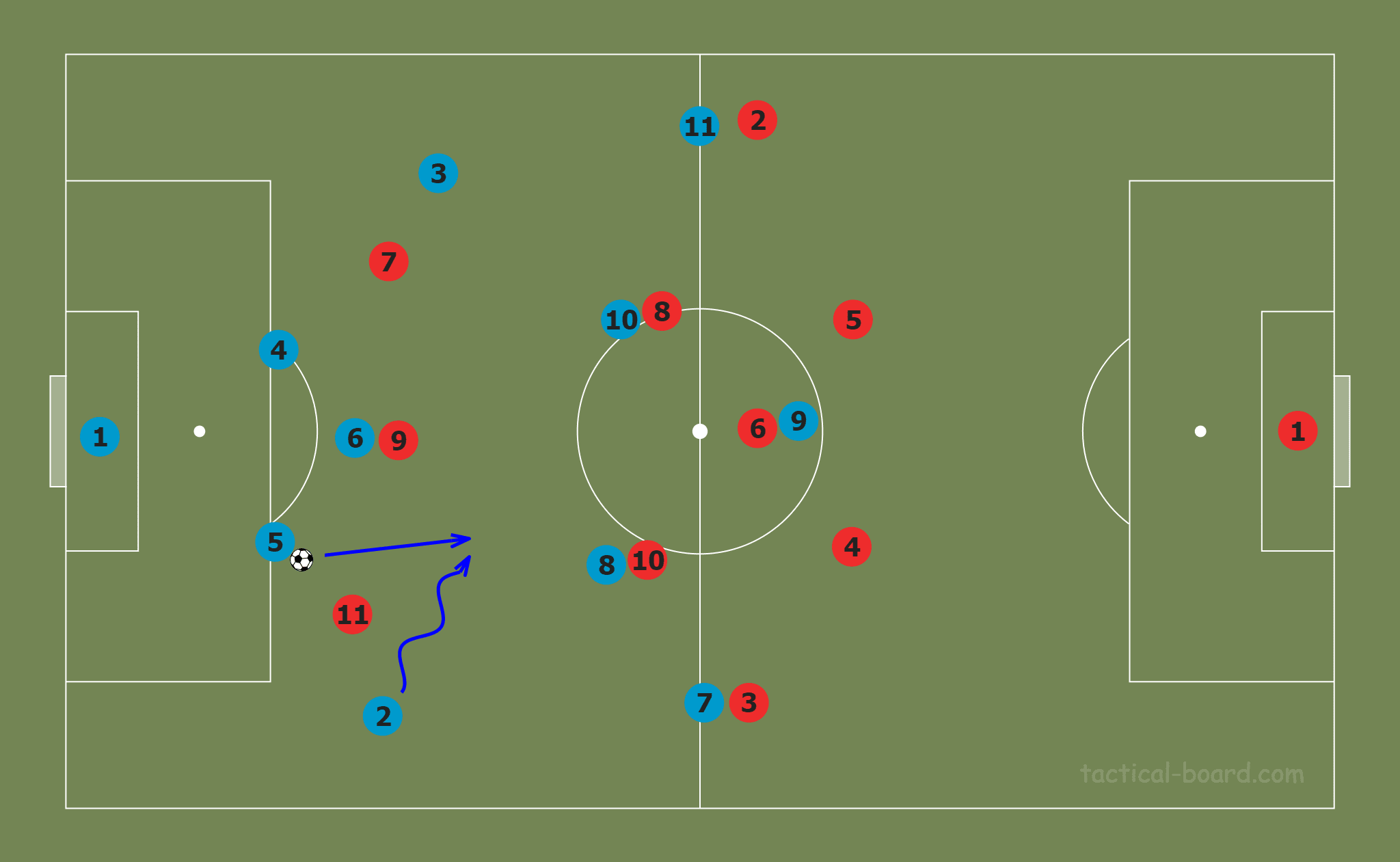
As we can see above, unlike the 4-2-3-1, there is no designated ‘10’, which is helpful in this case as that area of the pitch is where an inverting full-back would receive possession. The blue centre-midfielders are effectively pinning their markers, although the opposition ‘6’ may have the freedom to advance and become an auxiliary ‘10’ – something we’ve seen Fabinho do for Liverpool this season on occasion. The roles of the opposition front three are similar to those in a 4-2-3-1, albeit the striker needs to be warier of the pivot’s movements in the absence of a ‘10’. Nonetheless, the core principles remain the same for the offensive team. A curved pressing run from the opposition winger (no.11) can prompt an inversion into the somewhat empty pivot space. The likelihood of this being successful can increase if the pivot temporarily drops into the defensive line, bringing his marker with him, thus giving the full-back more space the receive.
How viable are inverted full-backs against a three-man defence? Well, I think more so, depending on the midfield structure though. A 3-4-3 containing just two central-midfielders creates conditions arguably perfect for full-backs inverting versus a 4-3-3. The only alteration in this formation compared to a 4-3-3 is the pivot becoming a centre-back, resulting in less presence centrally. A 3-4-2-1 or 3-4-1-2 like that employed by Julian Nagelsmann at RB Leipzig though would mean the full-backs inverting wouldn’t be a wise strategy. This is because of the now intense central occupation, as well as the wide channels where full-backs traditionally operate being vacant.
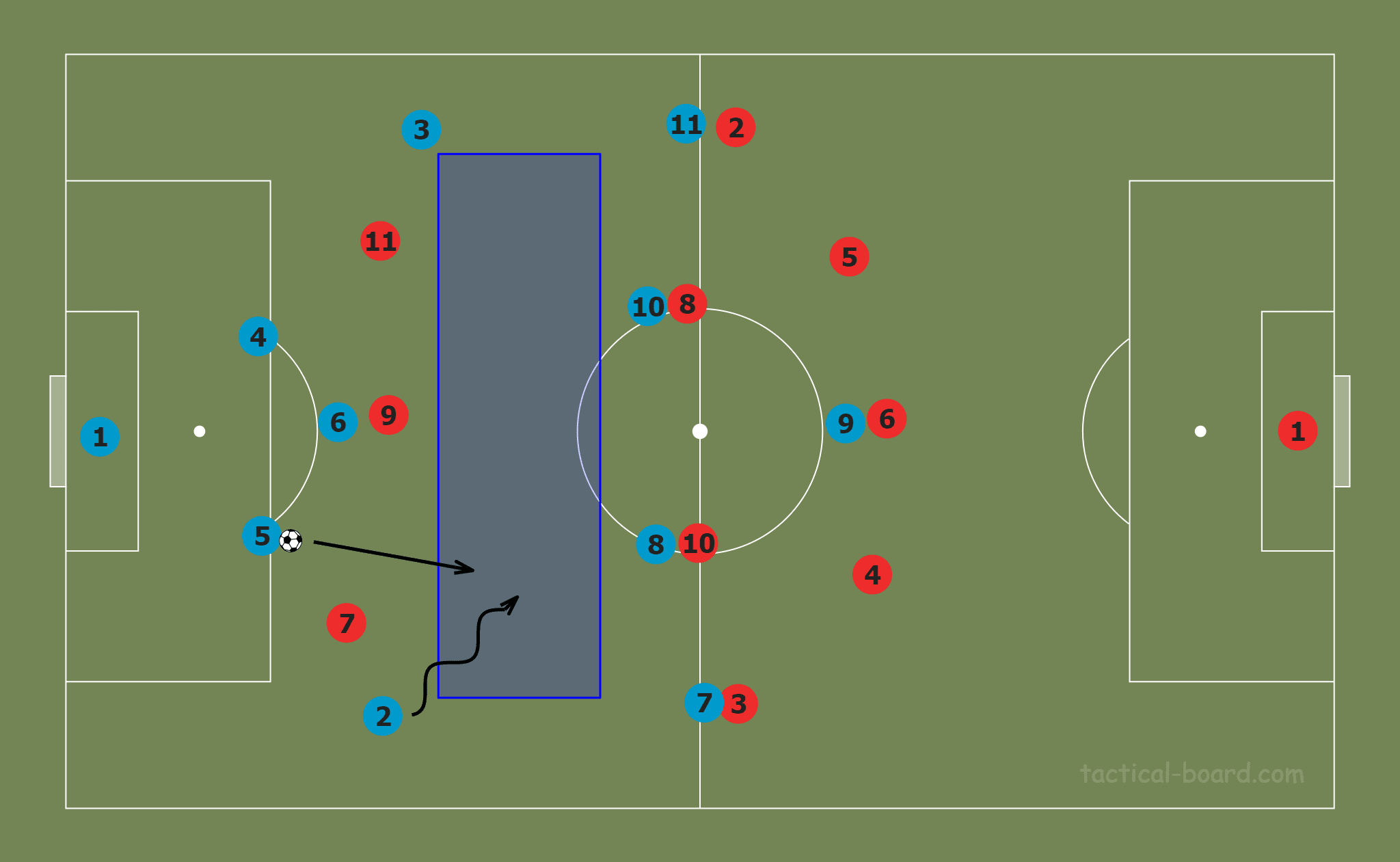
In the image above a large amount of space between the forwards and midfield is evident. This allows for the inversion of the full-backs to a greater extent. The increased space potentially means the full-back can receive on the move, or arrive there, encouraging dynamic movements. Contrast this to the image below, whereby the opposition is playing a 3-4-2-1.
The logical pass is out-wide, to exploit the free space there. The whole purpose of inverted full-backs is to bypass pressure and take advantage of situational superiorities that have arisen centrally. But, when there is such a situation as shown, it is important to apply common sense and still use classic methods for ball progression.
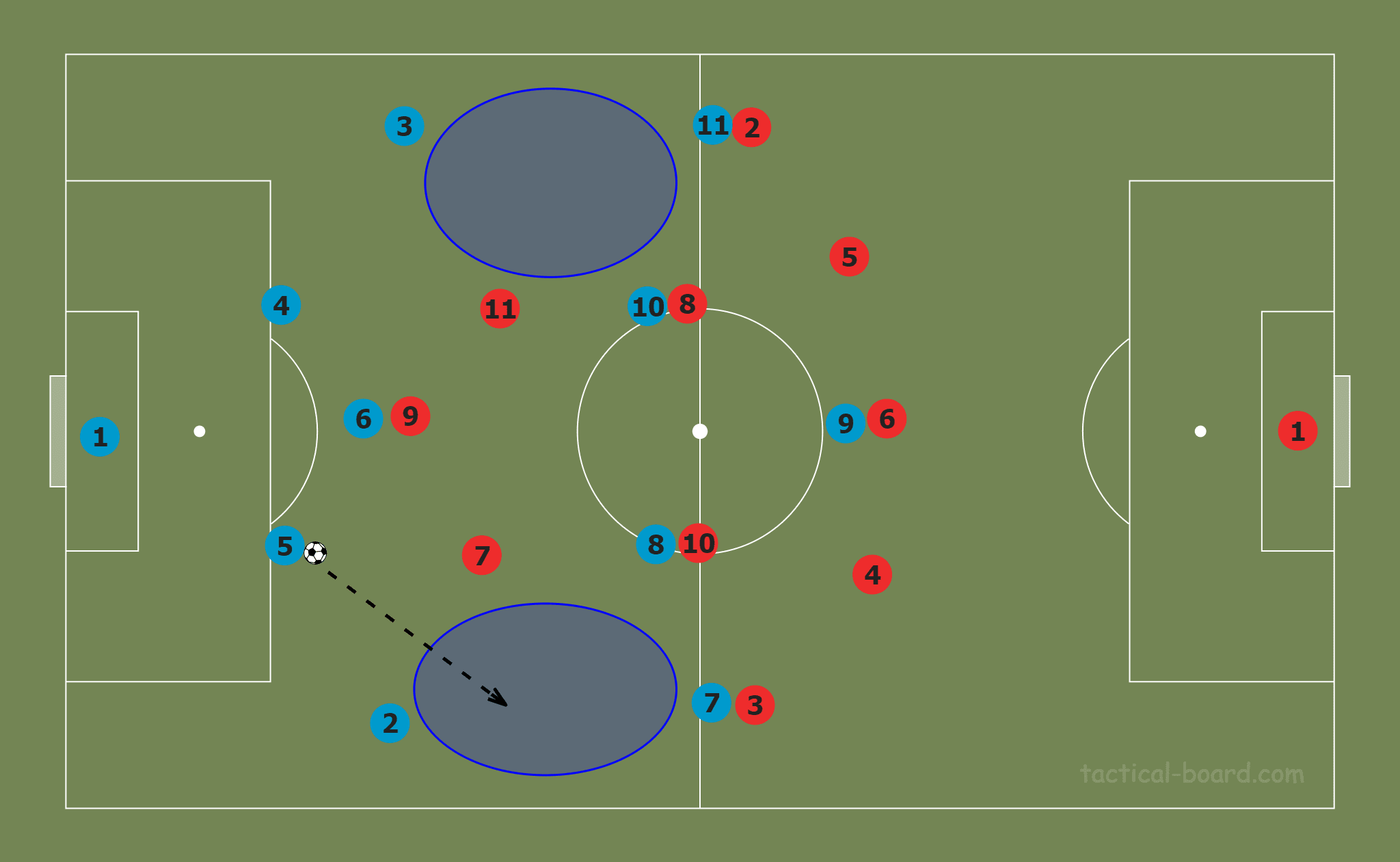
Offensive phase
Inverted full-backs can help maximise the skillsets of their teammates in other, more offensive positions. Their occupation of the centre and half-space can allow the wingers to stay wider, which can suit them if they’re particularly good at dribbling directly. The space afforded is especially useful if the wingers’ strong foot is the side they’re playing on, like a traditional winger in the mould of Leroy Sané.
The book Pep Confidential documents the moment of Guardiola formulating his innovation, and detailing it. “Rafinha and (David) Alaba are no longer full-backs at that point – they join the midfield. In principle, they occupy the space infield…”. That quote implies two things: ensuring control and superiority of the central regions and creating space for the wingers.
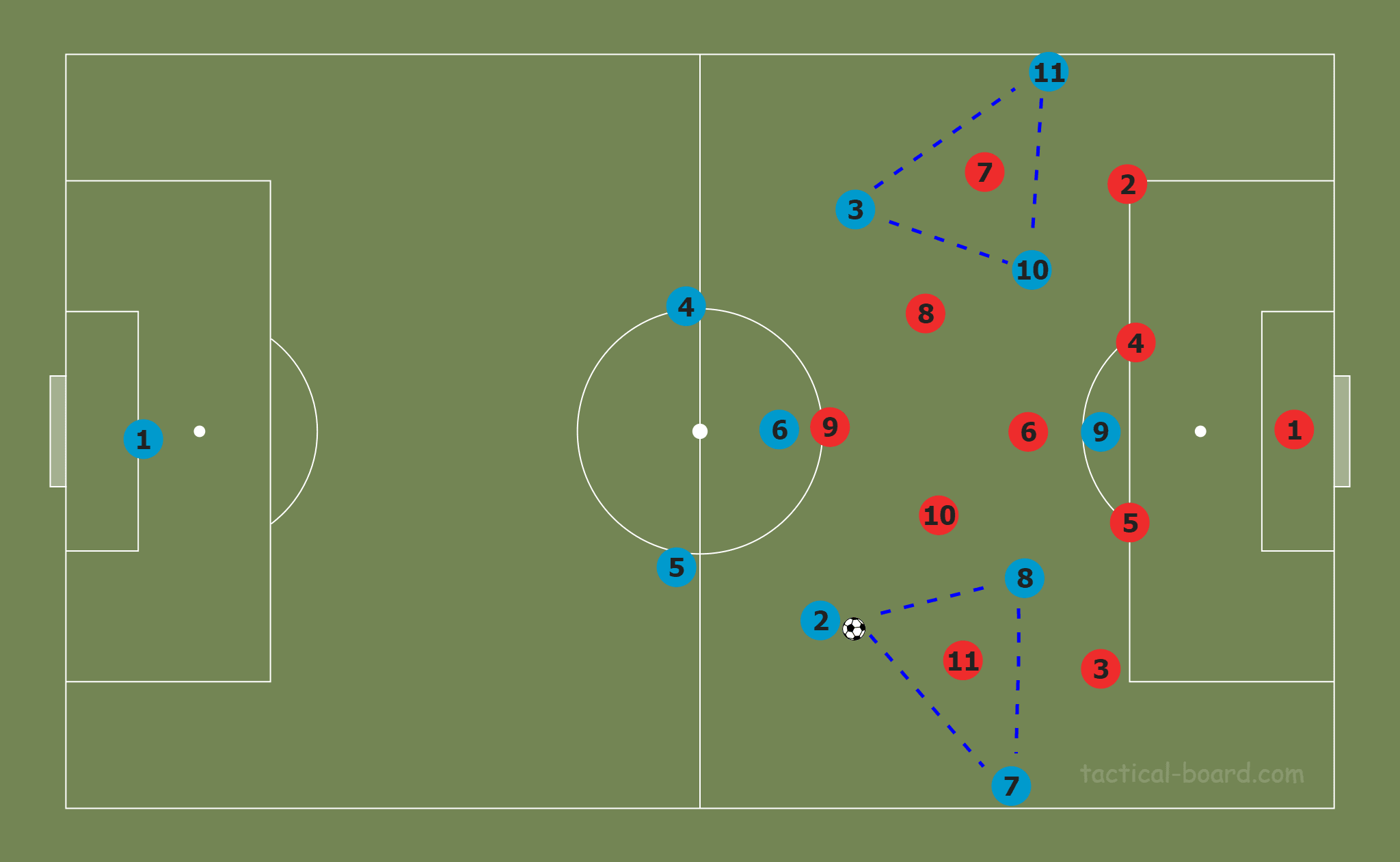
The image above portrays the broad attacking structure with inverted full-backs. What is apparent, in conjunction with the role of the attacking midfielders between the lines, is the triangles that have been created. Furthermore, an overload(s) has been generated over the opposition winger and full-back. The attacking inverted full-back can either pass to the winger, who would have a 1v1, or to the ‘8’ in a dangerous position where he has numerous possibilities, for example then playing a slide pass in-behind to the striker due to the left-centre-back having to shift across and pressure the ‘8’/RCM.
These potential attacking opportunities all stem from the positioning of the inverted full-back. Their occupation in the half-spaces is better spacing relative to their teammates, thus forming triangles and overloads, making compact defending more difficult for the opposition, with the inevitable conclusion of space opening up to be exploited by the forwards.
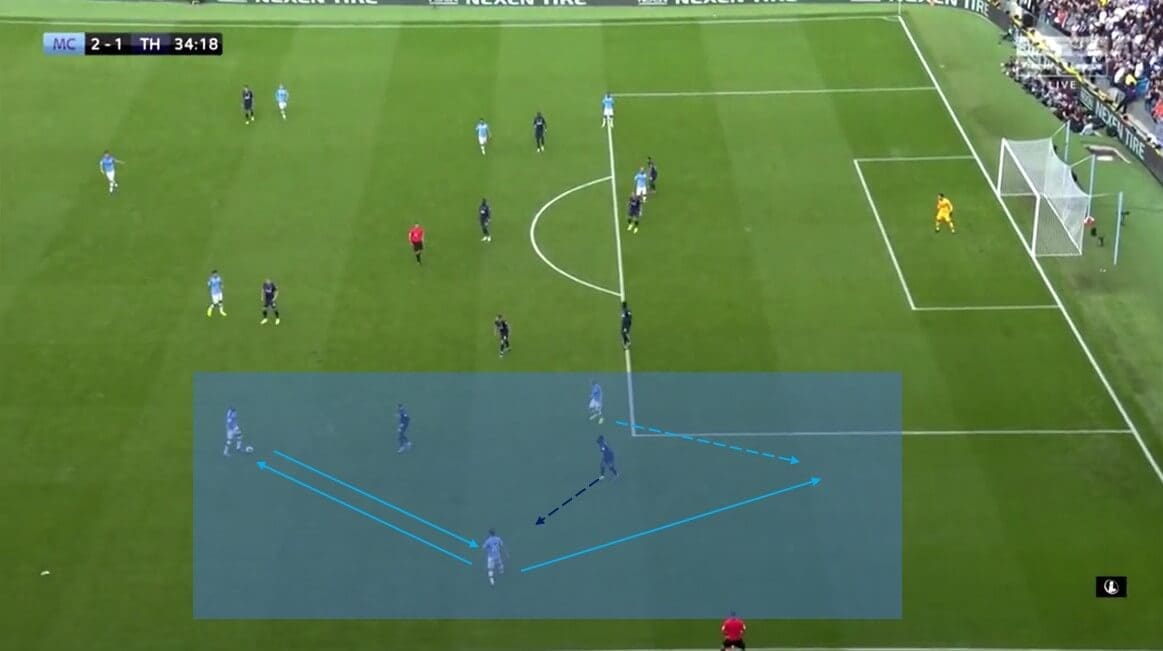
We can see this play out in the example above from Man City’s second goal against Tottenham. In the wide channel, a 3v2 overload has been set-up. Right-winger Bernardo Silva initially plays a diagonal pass back to Kyle Walker, causing Christian Eriksen to push out. Seeing this, Walker immediately returns the pass. This pass triggers Spurs left-back Danny Rose to pressure Silva, despite having no cover behind him. Unsurprisingly Silva slips in Kevin De Bruyne to cross for Sergio Agüero to finish. This goal is possible because of Walker’s slightly inner positioning. If he had been on the touchline on the same vertical line as Silva, then the passing lane would have been shut by Eriksen’s pressing movement.
As they are usually situated in the half-spaces, the full-backs are more suited to underlapping in the final third, rather than an overlap that we expect from a player in that position. The winger hugging the touchline can attract the opposition full-back, generating a gap between full-back and centre-back that the inverted full-back can run into and cross from. Continuing with the concept of the aforementioned triangle, such a run can also drag a marker with them, leaving the ‘8’ free to cross from deep. Nevertheless, it is important a rotation like this with the ‘8’ occurs anyway in order to maintain balance to the attack in addition to keeping an appropriate rest defence. What I’ve explained is visible in the illustration below.
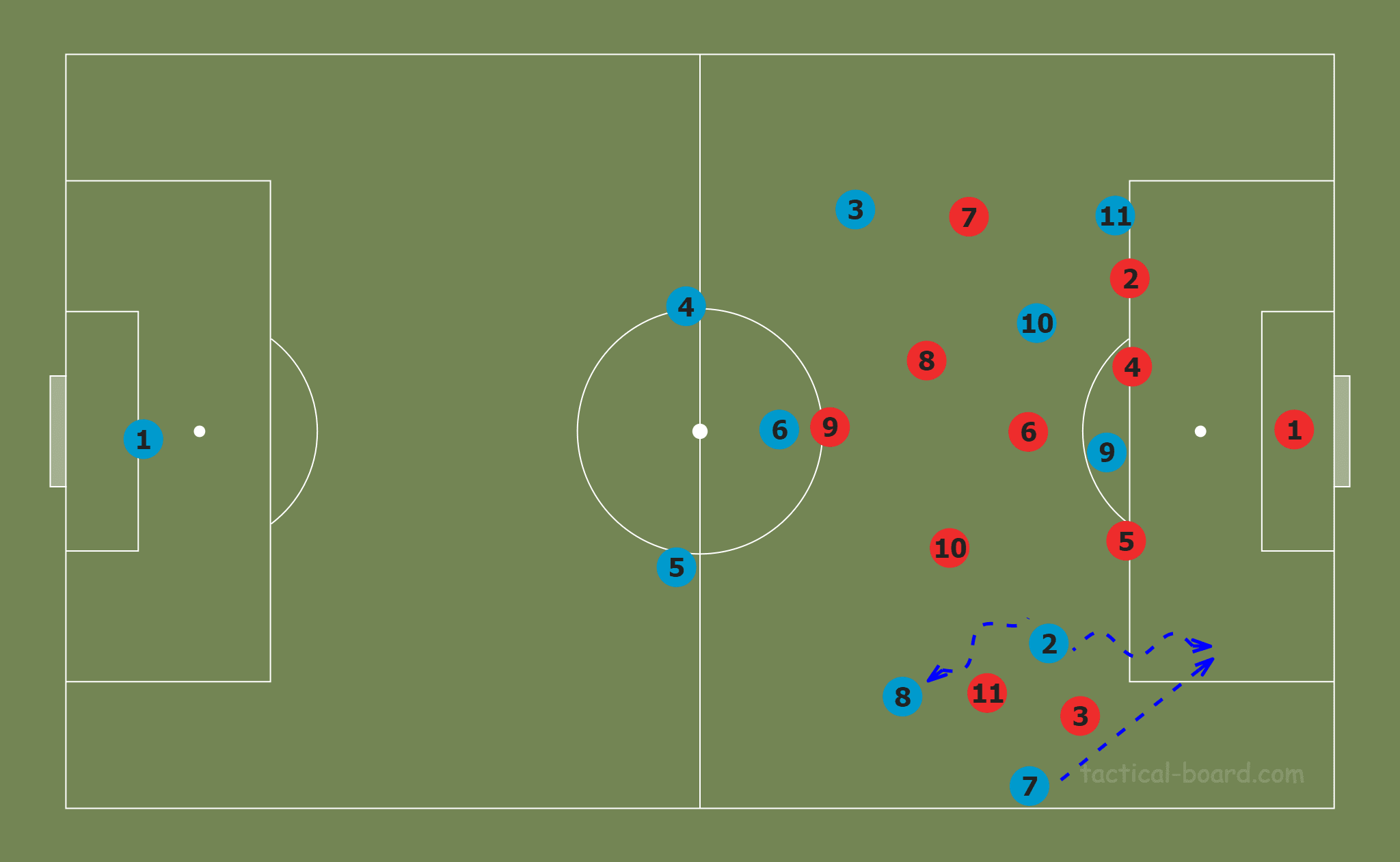
Defensive role
As the basis of an inverted full-back is that they are positioned centrally, they are in a more suitable area to make a defensive impact, especially when they are defenders first and foremost.
I see the main defensive responsibility of an inverted full-back as preventing counter-attacks at the source and allow there to be an easier defensive transition for his team if necessary. Rest defence is a key component of their role, they need to keep a solid structure so in the case of a turnover an effective counter-press can be launched. The most common structure for a rest defence is 2-3, meaning a 5-5 split of offensive and defensive players. The five structure of the five defensive players can be seen below.
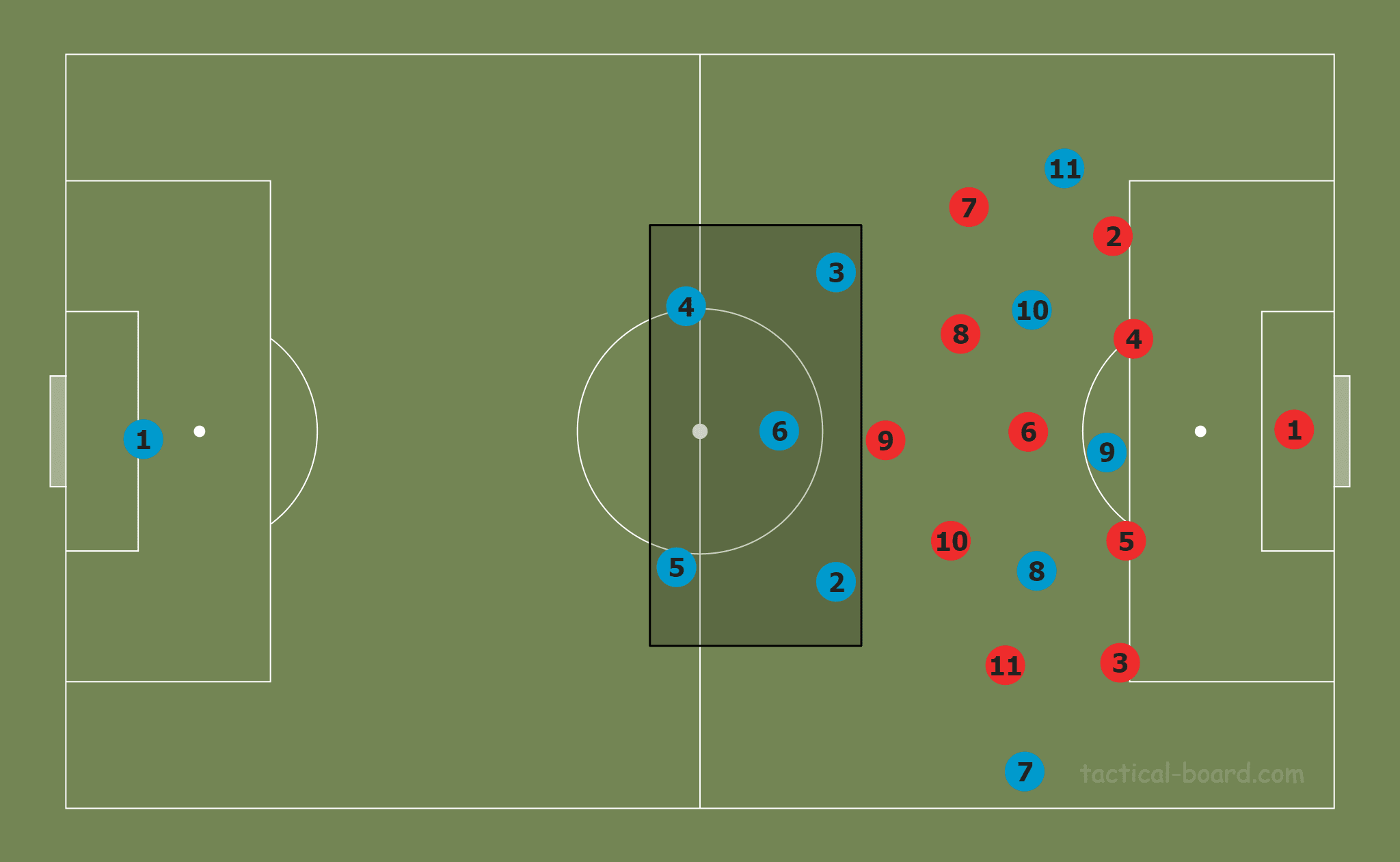
Instead of being wide as you would expect, which would leave the centre-backs and pivot exposed and isolated to counter-attacks, the full-backs have inverted. This means they are closer to their teammates, allowing for a more compact defensive shape that is harder to penetrate. Of course, the wings are sacrificed by this action, therefore there is a duty upon the offensive wingers to cover defensively if required.
To play this vitally important role your defensive positioning and intelligence needs to be superb. Even with the best players like Walker, there are instances where they can be exposed. When this happens, it highlights the absolute importance of a coordinated defensive unit. This example below illustrates how problems can arise via even seemingly negligible mistakes.
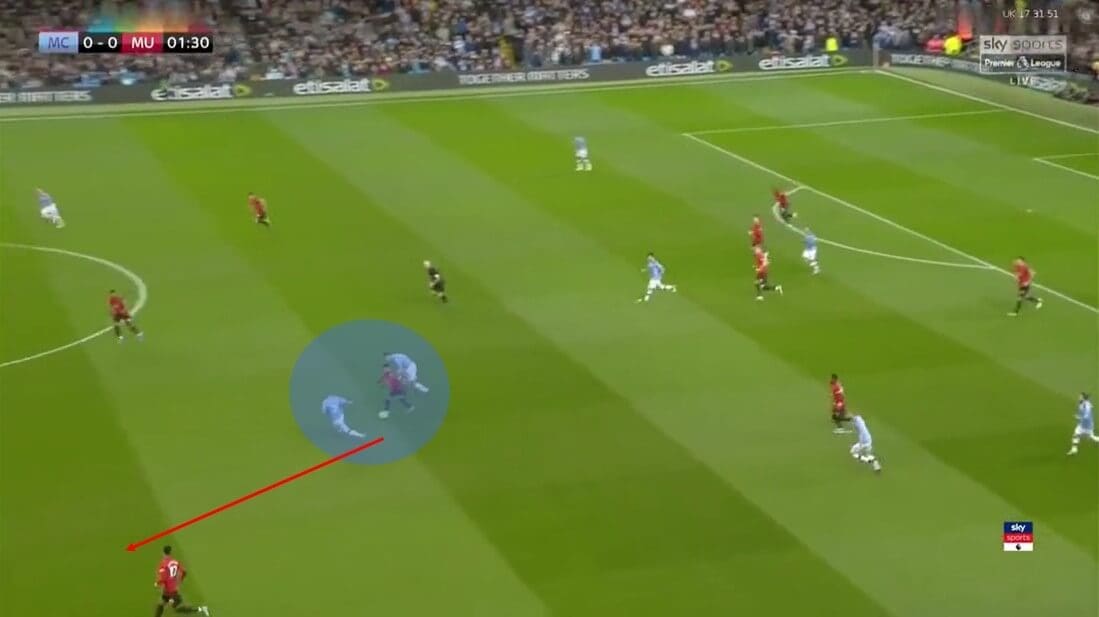
Rodri first botches his pressing attempt by being too aggressive and getting spun by Jesse Lingard. Even more importantly, Walker then mistimes how he pressures Lingard, the England international is excessively eager with poor body-orientation, allowing Lingard to side-step him. The consequence of Walker’s aggression combined with his inverted positioning is Marcus Rashford being free on the wing, where Walker would usually be.
Conclusion
To conclude this tactical analysis, we can see the effects of inverted full-backs in-possession and out-of-possession. It is a risky tactic, but when executed under the right conditions, it can be very profitable and help the team get out of difficult scenarios. Although, its complex nature and the demands it places on the full-backs may be why it is a concept not seen often.





Comments